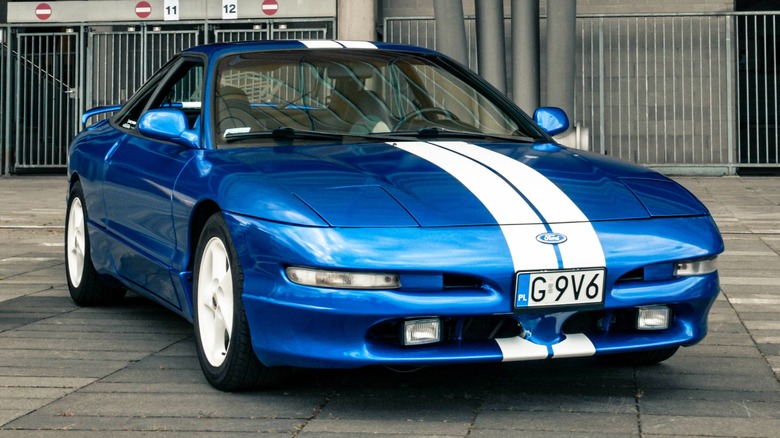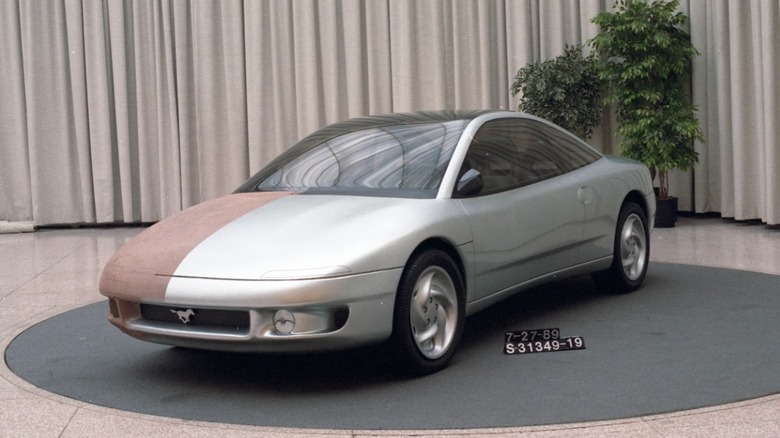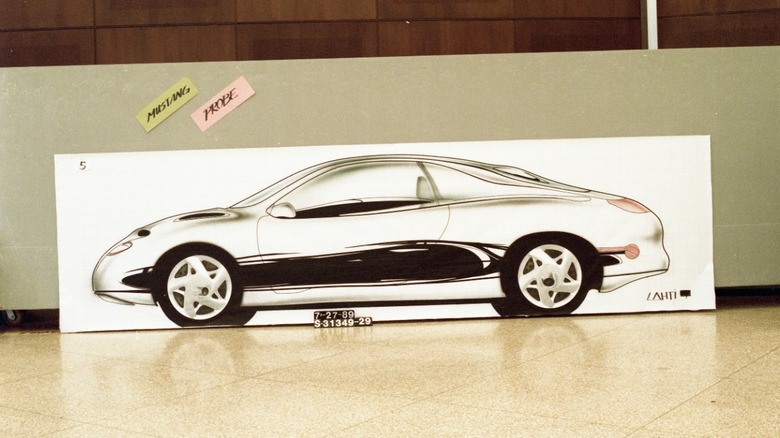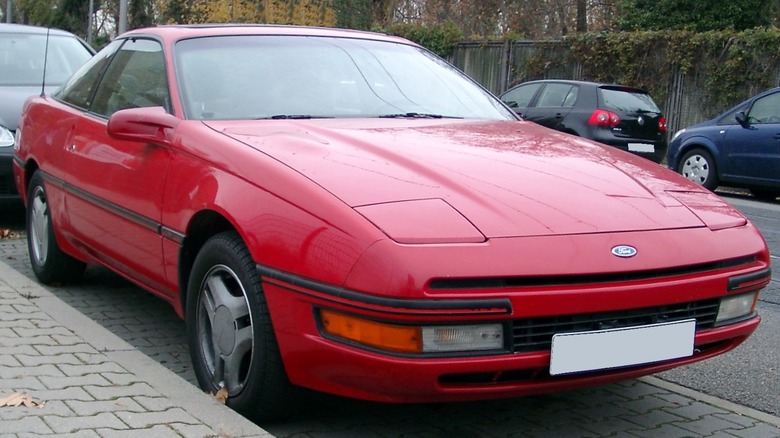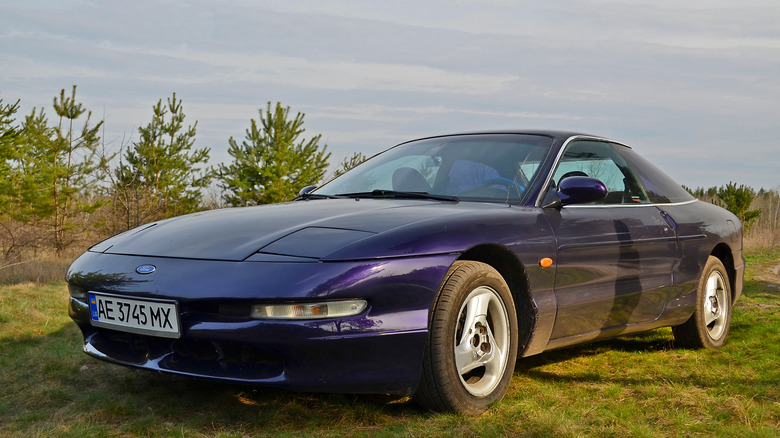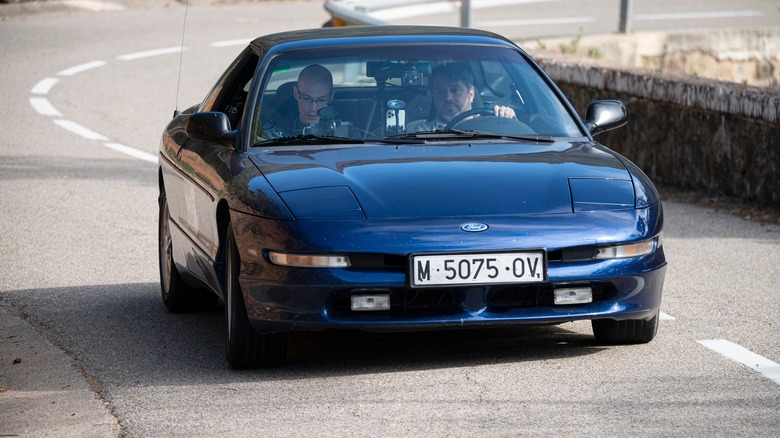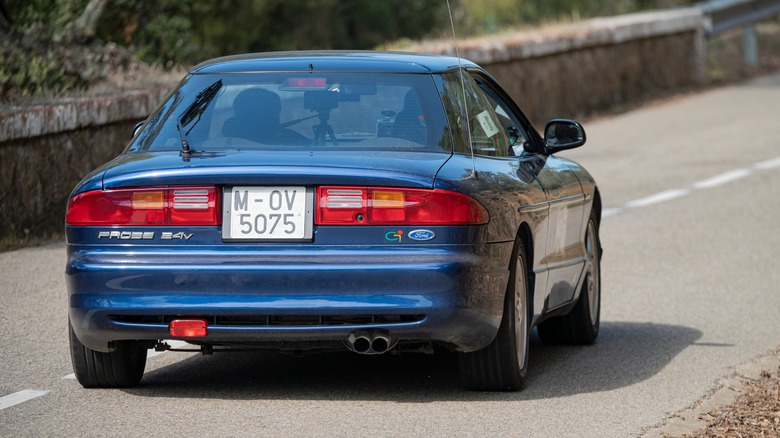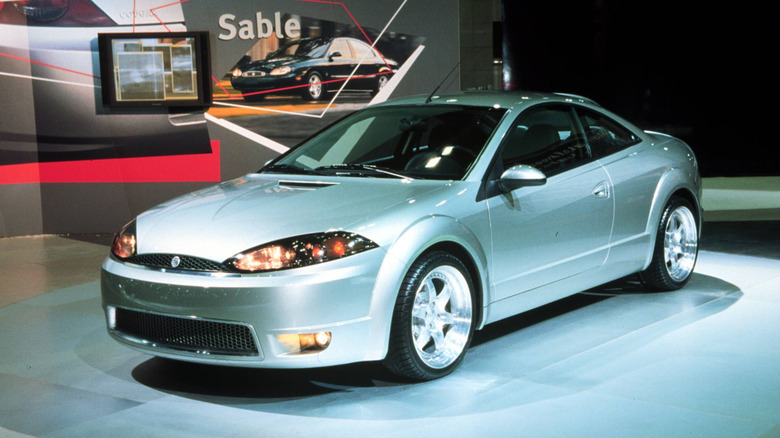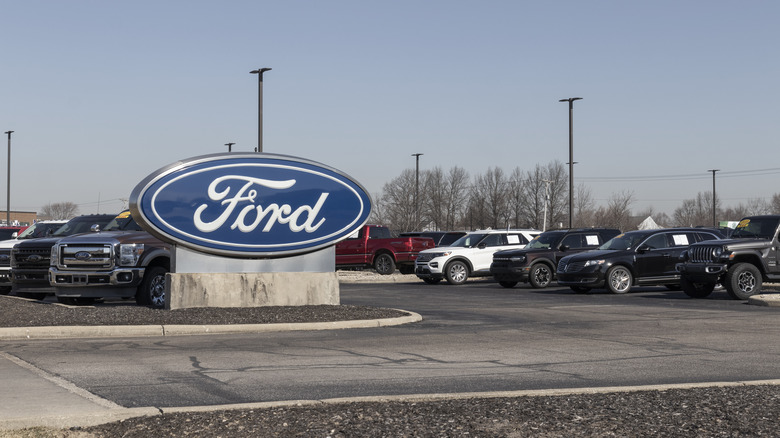The Mazda Powered Coupe That Almost Replaced The Ford Mustang
In April 2023, Ford confirmed that the Mustang was the world's best-selling sports car over the course of the previous decade, with the new 2024 Mustang just around the corner. That new, seventh-generation Mustang doesn't mess with the formula –- it's a rear-wheel drive, affordably-priced two-door coupe with a V8 available under the hood. Leaving aside the introduction of the Mustang Mach-E, that same formula has been used for every previous generation of the Mustang, stretching right back to when the first examples of the car were delivered to customers in 1965.
However, in the late '80s, consistently high fuel prices and cost-cutting measures meant that the Mustang almost became a front-wheel drive coupe based on a Japanese car. It sounds like heresy today, and it was just as controversial back then. However, if enthusiasts and the media hadn't kicked up such a storm over the impending change, Ford might well have gone ahead with its original plans.
In the end, Ford caved to the pressure and kept the Mustang true to its original formula — but here is the story of the planned replacement car that eventually became the Probe.
Ford's internal battle
At the time that the fourth-generation Mustang was entering development, the bosses at Ford were looking for a way to modernize the sports car to appeal to a wider audience. Front-wheel drive cars were popular, they reasoned, and a front-wheel drive platform would potentially be cheaper to produce. However, the company's finances weren't in great shape, so developing an all-new sports car platform was out of the question. This is where Ford's partner Mazda came in — the Japanese automaker had already developed the 626 platform, which could be adapted with American styling and sold with the iconic pony badge.
Plenty of senior figures at Ford disagreed with the idea, worried that the drastic change in both performance and heritage would alienate the Mustang's core buying demographic. To make things worse, the 626 platform wasn't built for a V8, and so Ford would have had to convince buyers a V6 would be a worthy replacement. A tall order, to say the least. Nonetheless, executives continued pushing the idea, with a Mazda-based front-wheel drive sports car taking shape over the following months.
Public outrage
Everything changed in April 1987 when the media first saw leaked plans to replace the Mustang. The news spread like wildfire among enthusiasts, and reactions were almost unanimously negative. Extensive media coverage of the leaked plans over the following weeks led to Mustang owners deciding to take action, writing letters to Ford to express their outrage over the idea. As the pushback grew, Ford was left with little choice but to listen to its customers, and the decision was eventually made that the Mustang would be redesigned separately, sticking to the traditional formula.
However, this left the company with a dilemma. It had a front-wheel drive sports car already developed and a partner ready to begin production of its components, but its plan to market the car using a well-established name had been canned at the last minute. If it couldn't be a Mustang, then what could the coupe be called?
The decision was made to name it after a series of experimental concept cars that had inspired its design -– it was christened the Probe, a name that ultimately proved to be a mistake.
Probe versus Mustang
The Probe was released in 1989 to sit alongside the Mustang in Ford's lineup, but by this point, it had already become known as the car that nearly spoiled one of the brand's most revered nameplates. Even so, it attracted plenty of attention from buyers who were looking for a modern, efficient sports car, and at first, Ford struggled to churn out Probes fast enough.
The car was available with a choice of two engines at launch –- a base-spec four-cylinder engine with around 100 horsepower and a top-spec turbocharged variant with 145 horsepower. A 3.0L V6 was also available but didn't offer any additional horses compared to the turbo four-pot. While these figures were reasonable for the time and roughly comparable to what Ford's Japanese rivals were offering, they were no match for the performance of the Mustang. For a short time, the Probe outsold the Mustang, but not for long. Once the initial hype had passed, sales began to slump.
[Featured image by Rudolf Stricker via Wikimedia Commons | Cropped and scaled | CC BY-SA 3.0]
A second generation
To combat declining sales figures and breathe new life into the line, a second-generation Probe was launched for the 1993 model year. Ford tried to spin the new generation as a more American product, telling reporters that the car had a lot more input from Ford's own design team this time around. The previous generation, it was explained, was more Mazda than Ford, but the new car saw the American manufacturer given more freedom to alter the platform's design for optimal handling while reworking the styling to be more distinctly home-grown.
It seemed to work, at least in the beginning. Reviews indicated that the second-generation Probe was better to drive than before, and there was a slight power boost too, with the new 2.5L V6 producing 164 horsepower. Despite Ford's assurances, however, that new engine was still designed by Mazda –- hardly an all-American sports car, then.
The Probe also launched in international markets for its second generation, where its unfortunate name proved to be a sticking point. In the UK, the car saw some success as the follow-up to the Capri, but its name drew plenty of ridicule and even got picked up as a running joke by Steve Coogan, one of the nation's biggest TV comedians.
Tough competition
The biggest hurdle that the Probe couldn't overcome in its later years was how to differentiate itself from the competition. In America, rival sports coupes from Japanese manufacturers like Nissan, Honda, and Mazda had all eaten into the Probe's market share, offering superior performance, reliability, or technology. Not only that, but internal competition was taking its toll. After all, the Mustang was still, well, a Mustang, and enjoyed a loyal fanbase even though the Fox body had been in production since the late '70s.
This internal competition was compounded in 1994 when the new, fourth-generation Mustang finally arrived. It featured improvements to performance, reliability, and safety, further drawing buyers away from the ailing Probe. Its V8 engine and rear-wheel drive layout were very familiar to buyers, and the Mustang nameplate still carried a prestige that the Probe simply couldn't match.
Elsewhere in Ford's lineup, the tenth-generation Thunderbird also offered superior luxury to the Probe, even if it wasn't as fun to drive.
The end for the Probe
Despite receiving plenty of acclaim for its driving dynamics, sleek design, and relative efficiency for a sports car, the Probe simply couldn't compete with the latest and greatest in the sports coupe segment, which led sales to slump throughout the mid-'90s. In 1997, it was announced that the Probe would be discontinued, as sales figures were down to less than a fifth of the Mustang's numbers. Less than 20,000 units were sold in the final model year, a small fraction of the roughly 310,000 examples of the car that had been produced overall.
It was a very unceremonious end for a car that had been plagued by issues from the start. Positioning a rebodied Mazda as a Mustang was always going to be a terrible idea, but once that plan was scrapped, Ford still managed to put the Probe at a disadvantage by giving it such an awkward name. Even so, the finished product was undeniably decent as a mass-market sports coupe, even if it never managed to stand out.
A third generation that never was
At the time the decision was made to axe the Probe in 1997, Ford actually had a successor already in the works. In a strange case of deja vu, the automaker now had a car that was quite far along in development but no nameplate with which to sell it under. The Probe name was gone, and there was no question this time around that the Mustang name would remain out of the picture for this front-wheel drive, mildly sporty coupe.
Instead, the decision was made to rebrand the new car as a Mercury, and thus, the final generation of the Mercury Cougar was born. Much like its ill-fated predecessor, the Cougar struggled to meet Ford's sales expectations, as Mercury's dealerships weren't the sort of place most buyers would go for a sports coupe. The car itself was based on the Contour rather than the Mazda platforms of old, and surprisingly, it ended up limping on until two years after the Contour was retired, finally getting the chop in 2002. Years of disappointing sales of both the Probe and the Cougar meant that Ford planned no immediate successor.
Little chance of a revival
It should come as no surprise that, with its awkward name and lukewarm reception, Ford has made no effort to revive the Probe nameplate in the years since its initial demise. Every so often, an unofficial render surfaces that tries to envision what the car might look like if it was reinvented for the modern market, but there are a number of reasons why that's unlikely to ever happen.
The first is that the mildly sporty, two-door coupe segment is much smaller than it once was, with buyers generally preferring more practical crossovers and SUVs. Today's sports cars also have to offer outstanding performance or handling to make waves in what's become a highly competitive market. While the Probe was, by all accounts, generally good to drive, it was far from what most people would consider outstanding.
However, perhaps the biggest reason we're unlikely to see a revived Probe is that Ford simply has so many other legendary nameplates at its disposal, all of which have more cachet than the Probe. In fact, there are so many classic Fords that deserve a comeback Ford would have to be mad to even consider bringing back the Probe. Then again, some would say it was mad for attempting to create a front-wheel drive Mazstang in the first place, and we'd be inclined to agree.
